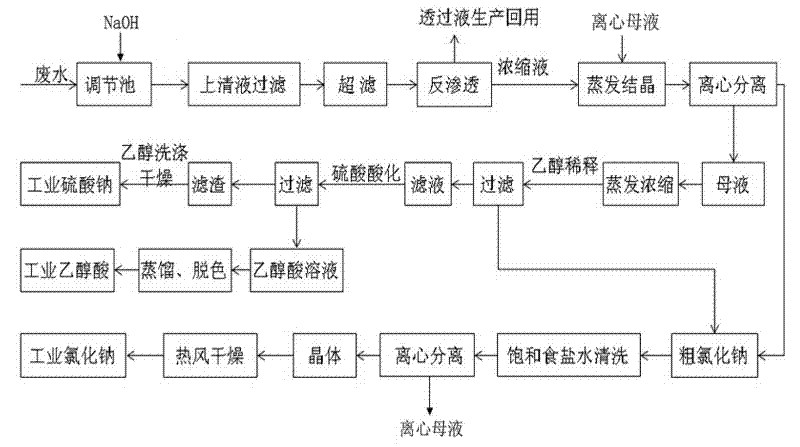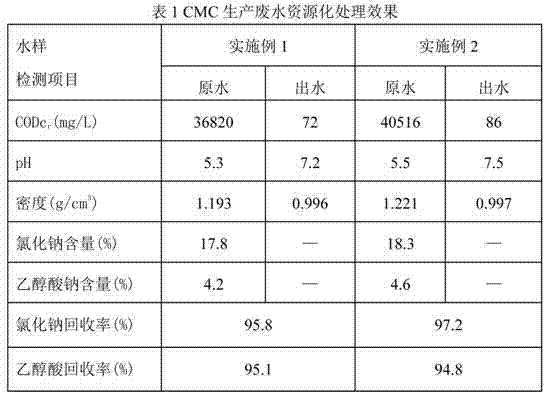Recovery treatment method for wastewater generated in production of carboxymethyl cellulose
A technology for carboxymethyl cellulose and waste water production, which is applied in chemical instruments and methods, water/sewage multi-stage treatment, water/sludge/sewage treatment, etc. Salt recovery and other problems, to achieve the effect of less difficulty in operation and management, good effect, and reduced energy consumption
- Summary
- Abstract
- Description
- Claims
- Application Information
AI Technical Summary
Problems solved by technology
Method used
Image
Examples
Embodiment 1
[0028] A resource treatment method for carboxymethyl cellulose production wastewater, the process flow chart is shown in figure 1 ,Specific steps are as follows:
[0029] 1) Pump the wastewater produced by carboxymethyl cellulose into the adjustment tank, add NaOH, stir, adjust the pH of the wastewater to 8, and perform primary filtration with a filter device to remove impurities such as macromolecular organic matter and suspended solids in the wastewater to obtain the primary filtrate ;
[0030] 2) The primary filtrate is pressurized into the ultrafilter to further filter out harmful substances such as colloidal particles, bacteria, and viruses in the wastewater, and the filtrate is pressurized into the reverse osmosis device for concentration and separation to obtain reverse osmosis concentrate and reverse osmosis permeate;
[0031] 3) Send the reverse osmosis concentrated liquid into the falling film evaporator for concentration and crystallization, and when the concentrat...
Embodiment 2
[0037] A resource treatment method for carboxymethyl cellulose production wastewater, the process flow chart is shown in figure 1 ,Specific steps are as follows:
[0038] 1) Pump the wastewater produced by carboxymethyl cellulose into the adjustment tank, add NaOH, stir, adjust the pH of the wastewater to 9.5, and perform primary filtration with a filter device to remove impurities such as macromolecular organic matter and suspended solids in the wastewater to obtain the primary filtrate ;
[0039] 2) The primary filtrate is pressurized into the ultrafilter to further filter out harmful substances such as colloidal particles, bacteria, and viruses in the wastewater, and the filtrate is pressurized into the reverse osmosis device for concentration and separation to obtain reverse osmosis concentrate and reverse osmosis permeate;
[0040] 3) Send the reverse osmosis concentrated liquid into the falling film evaporator for concentration and crystallization, and when the concentr...
Embodiment 3
[0046] A resource treatment method for carboxymethyl cellulose production wastewater, the process flow chart is shown in figure 1 ,Specific steps are as follows:
[0047] 1) Pump the wastewater produced by carboxymethyl cellulose into the adjustment tank, add NaOH, stir, adjust the pH of the wastewater to 10, and perform primary filtration with a filter device to remove impurities such as macromolecular organic matter and suspended solids in the wastewater to obtain the primary filtrate ;
[0048] 2) The primary filtrate is pressurized into the ultrafilter to further filter out harmful substances such as colloidal particles, bacteria, and viruses in the wastewater, and the filtrate is pressurized into the reverse osmosis device for concentration and separation to obtain reverse osmosis concentrate and reverse osmosis permeate;
[0049] 3) Send the reverse osmosis concentrated liquid into the falling film evaporator for concentration and crystallization, and when the concentra...
PUM
 Login to View More
Login to View More Abstract
Description
Claims
Application Information
 Login to View More
Login to View More - R&D
- Intellectual Property
- Life Sciences
- Materials
- Tech Scout
- Unparalleled Data Quality
- Higher Quality Content
- 60% Fewer Hallucinations
Browse by: Latest US Patents, China's latest patents, Technical Efficacy Thesaurus, Application Domain, Technology Topic, Popular Technical Reports.
© 2025 PatSnap. All rights reserved.Legal|Privacy policy|Modern Slavery Act Transparency Statement|Sitemap|About US| Contact US: help@patsnap.com


